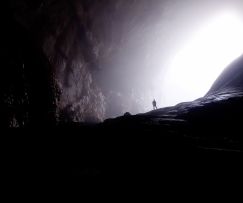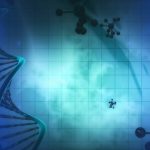By Georgi Y Johnson
[An extract from the book: Nondual Therapy: The Psychology of Awakening]
In wholeness, the energetic form of the psyche is like a vortex. In the words of father of Somatic Experiencing Peter Levine: “The vortex orchestrates symptoms to prevent the organism from being overwhelmed by it, and also attempts through devices such as re-enactment to reintegrate that energy in the large flow of experiencing.”
The center of the vortex is the eye of perception: the Source of all experience; the seer; the one through whom all sensation occurs. The center is like a perceptive point of singularity, receiving all the impressions that arise in awareness. Like a black hole, it pulls information into itself. When there is a trauma, the energetic material of the psyche is cut off from that whole and a secondary vortex forms – a trauma vortex. Here, the natural flow of receptivity and expression gets thwarted, as the trauma vortex doesn’t fit into the current context. As with every vortex, there is simultaneously contraction and expansion. The experience of the person contracts into the duality of the trauma, while at the same time the suffering quality of that trauma expands through all perception. When we’re in it, it seems that the attitudes, atmospheres and moods of the trauma fill the whole universe. Yet trauma is formed through the pain of rupture, and this pain is its dominant sentient quality. As Peter Levine says:
“The two results of polarization are expansion and contraction, so you have an undulation between the expansive quality of the energy movement and its contraction. That’s the normal response of that universe: expansion-contraction. As you go into the trauma vortex you could call that the compression vortex, then the experience is one of expansion.”
In trauma, the sense of belonging is lost. This is because of the historic inability to integrate the experiential content of the trauma with the habitual experience of daily life. The trauma doesn’t belong, it’s severed from the whole, and the whole can’t make sense of it. This split is often reinforced by social norms.
 For example, a young couple who lost their baby to Sudden Infant Death Syndrome struggled through the process of grief, first because of the horror of the loss, and secondly because of the horror of the people around them. They felt excluded by family and friends through subtle movements of shame, avoidance and denial. Even talk of babies would create an embarrassment, which meant others broke connection. The mother continued working, but she felt she had to constantly guard herself against traumatic triggers: shops with baby clothing, pregnant women, newly married couples. She lost connection to her own sexuality, as this was also a trigger, and the relationship with her husband began to suffer as each retreated behind different coping strategies and a distance appeared between the trauma in one and the trauma in the other. Easily, the shame and blame passed with subtle expressions between them, widening the rift. Yet the same splitting effect of trauma also held the keys to finding belonging again. When they could stand together, facing towards their child, allowing what was shared and the joy that filled the three of them in his short life, they began to belong again, firstly with the child and then with each other. The Nondual Quality of joy became the light that led the way to wholeness inside and outside of themselves. Only then did it become possible to conceive again.
For example, a young couple who lost their baby to Sudden Infant Death Syndrome struggled through the process of grief, first because of the horror of the loss, and secondly because of the horror of the people around them. They felt excluded by family and friends through subtle movements of shame, avoidance and denial. Even talk of babies would create an embarrassment, which meant others broke connection. The mother continued working, but she felt she had to constantly guard herself against traumatic triggers: shops with baby clothing, pregnant women, newly married couples. She lost connection to her own sexuality, as this was also a trigger, and the relationship with her husband began to suffer as each retreated behind different coping strategies and a distance appeared between the trauma in one and the trauma in the other. Easily, the shame and blame passed with subtle expressions between them, widening the rift. Yet the same splitting effect of trauma also held the keys to finding belonging again. When they could stand together, facing towards their child, allowing what was shared and the joy that filled the three of them in his short life, they began to belong again, firstly with the child and then with each other. The Nondual Quality of joy became the light that led the way to wholeness inside and outside of themselves. Only then did it become possible to conceive again.
The trauma doesn’t belong, it’s severed from the whole, and the whole can’t make sense of it. This split is often reinforced by social norms.
A trauma vortex, like an acute condition, can catch us unawares. It repeats the shock of its own inception. One moment a person is feeling fine, and then he sees a sick dog on the street which triggers his trauma, and then suddenly he is there: inside the trauma tunnel. Another area where trauma shows up is in intimate relationships, partly because both sexual and survival instincts process through the reptilian brain. Sexuality can be confused with abuse, betrayal and abandonment. One moment a couple is having a lovely dinner out at a restaurant, next moment, with the opening of the sexual connection with his wife in a public arena, the husband disappears into a trauma vortex. He loses his appetite, he becomes aggressive, his hands and feet become cold, he doesn’t care about the bill, his partner or his future – he feels he has none.
Our inner dimensions of trauma are places of intense suffering. They are characterized by a slowing down of physical movement and a difficulty in both expression and reception. At the same time, there can be a subtle grandiosity. It can feel as if we are standing in the deeper (grim) truth and that others are in illusion. Social interaction can feel like nonsense. It is as if only we know the keener, deeper truth of life. This truth is determined by the Nondual Quality that has been obscured. It can be the quality of life, for example: “Only I know death. Everyone dies. Everyone else is in denial,” or it can be the quality of trust: “The world is full of betrayal. Betrayal is the bottom line. Everyone is just out for himself. We’re all betrayed.” Notice the absolutist language of a traumatic state: everyone, all the time, everywhere, nobody, never. Also, the superiority claimed by the traumatic state over ‘others’.
There are always three or more Nondual Qualities locked in a trauma vortex. Chief among these are:
- Belonging: the traumatic conclusion tends to be that I don’t belong in this world.
- Connection: as the trauma vortex, while deeply intimate, is at the same time lonely – the sense of connectivity has broken down.
- Peace: as there is an existential conflict between two perspectives of consciousness.
- Discernment: the mind reacts with the ‘either-or’ thinking of survival. The middle way is lost. I am ‘good’, the other is ‘evil’.
- Life: trauma is linked to survival and often literally to the experience of death or birth.
- Innocence: as trauma brings a sense of condemnation, the legacy of guilt is strong, together with the reflex to blame the outside for the experience.
- Purity: especially in sexual trauma, the stain to the psyche can seem to be eternal, never to be cleaned.
In addition, a trauma vortex can move us even away from the differentiation of qualities – into the realm of existential angst. In the words of Nondual therapist Gary Tzu: “I could see that trauma was not limited to experiences of physical, emotional, and sexual abuse, or physical injury or death. It also included experiences of psychic engulfment with no escape, and could even entail witnessing experiences of the absence of existence itself… the non-judgment stance takes us straight to Ego death, and letting go of the Separate Self contraction so the client can drop the split-mind, the grasping at surviving, and rest in being and essence.”
Georgi Y. Johnson is author of the book Nondual Therapy: The Psychology of Awakening. Together her partner Bart ten Berge, she gives trainings in Nondual Therapy around the world. She is also available for online mentorship. http://www.iamhere.life












